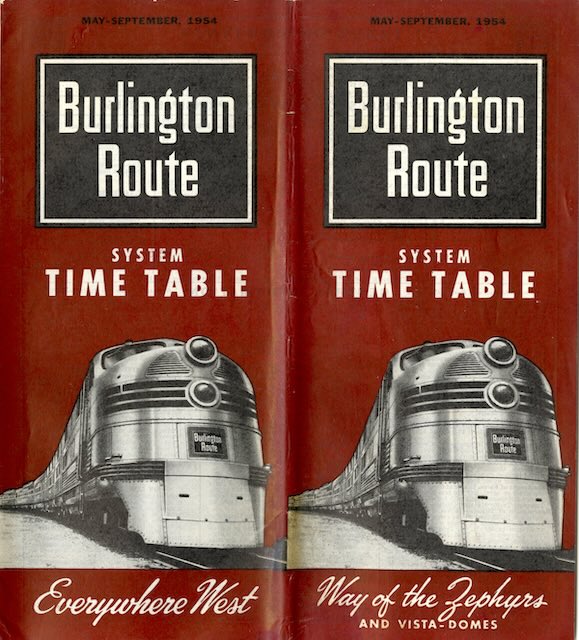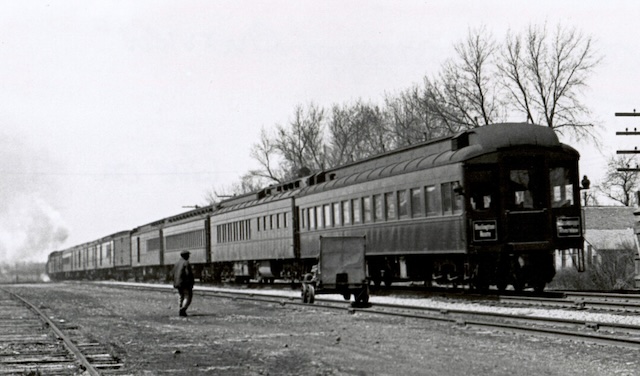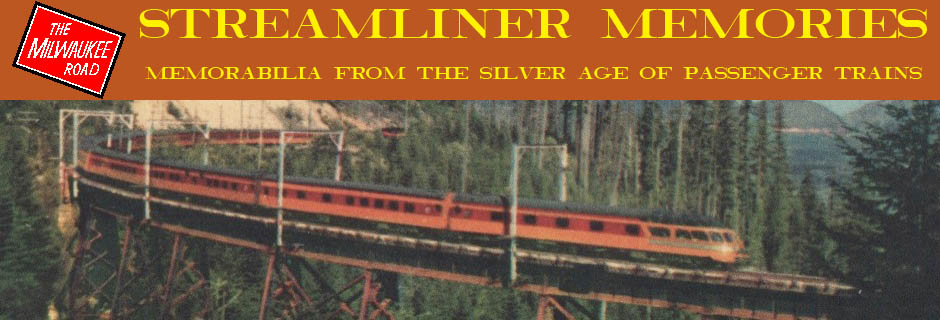Today’s timetable has the same Chicago-Twin Cities arrangement as yesterday’s. In short, the westbound Western Star preceded the combined Mainstreeter/Black Hawk out of Chicago by 10 minutes, while the eastbound Mainstreeter followed the combined Western Star/Black Hawk out of St. Paul by 15 minutes.
 Click image to download a 21.4-MB PDF of this 36-page timetable.
Click image to download a 21.4-MB PDF of this 36-page timetable.
This setup seemed to create a quandary for the Burlington. According to John Strauss’ Great Northern Pictorial Volume 4, the Western Star‘s dining and cafe cars went through to Chicago. But his Northern Pacific Pictorial Volume 5 says the Mainstreeter‘s dining car only went as far east as St. Paul, which meant Burlington had to supply a diner on the westbound train to serve breakfast. That diner had to get back to Chicago somehow. Did the eastbound train carry both Burlington and Great Northern diners?
Although Burlington had six trains a day each way between Chicago and the Twin Cities, one of those trains, unnamed 45 & 52, was an overnight train that carried only coaches. It was also slow as #45 left Chicago 2-1/3 hours before the Western Star and arrived in St. Paul almost two hours after, and #52 was similarly slow eastbound.
The history of 45 & 52 goes back to 1930, when Burlington numbered its portion of GN’s Oriental Limited 45 & 46 and its portion of NP’s Alaskan 52 & 53. Due to the Depression, these trains were cancelled on March 31, 1931, but Burlington still needed to operate a day train between Chicago and the Twin Cities, so it started a train called the Mississippi Riverview. For some reason, it assigned that train numbers 45 and 52 instead of 45 & 46 or 52 & 53.
 The Mississippi Riverview in Sugar Grove, Illinois, in 1935 before the introduction of the Twin Zephyrs. Click image for a larger view. Photo by A.W. Johnson; Krambles-Peterson Archive.
The Mississippi Riverview in Sugar Grove, Illinois, in 1935 before the introduction of the Twin Zephyrs. Click image for a larger view. Photo by A.W. Johnson; Krambles-Peterson Archive.
The above photo shows the train carrying a half-dozen head-end cars, a combination baggage-coach, a coach, a diner, and an observation-parlor car. By 1934, both the diner and observation-parlor car were air conditioned but the coaches were not.
On April 18 1935, Burlington introduced the daytime Twin Zephyrs and downgraded 45 and 52 by deleting its diner and observation-parlor as well as its name. The baggage/express cars in the above photo no doubt sustained the train after most passengers had gone to the Zephyrs.
Train 45 and 52 did serve local passengers by stopping at 41 towns that all other Burlington trains passed through without stopping. That was probably useful to residents of those towns through 1947 when 45 & 52 operated during daylight hours, but in 1948 it was turned into an overnight train, which meant many of those 41 towns were only served in the wee hours of the morning.
